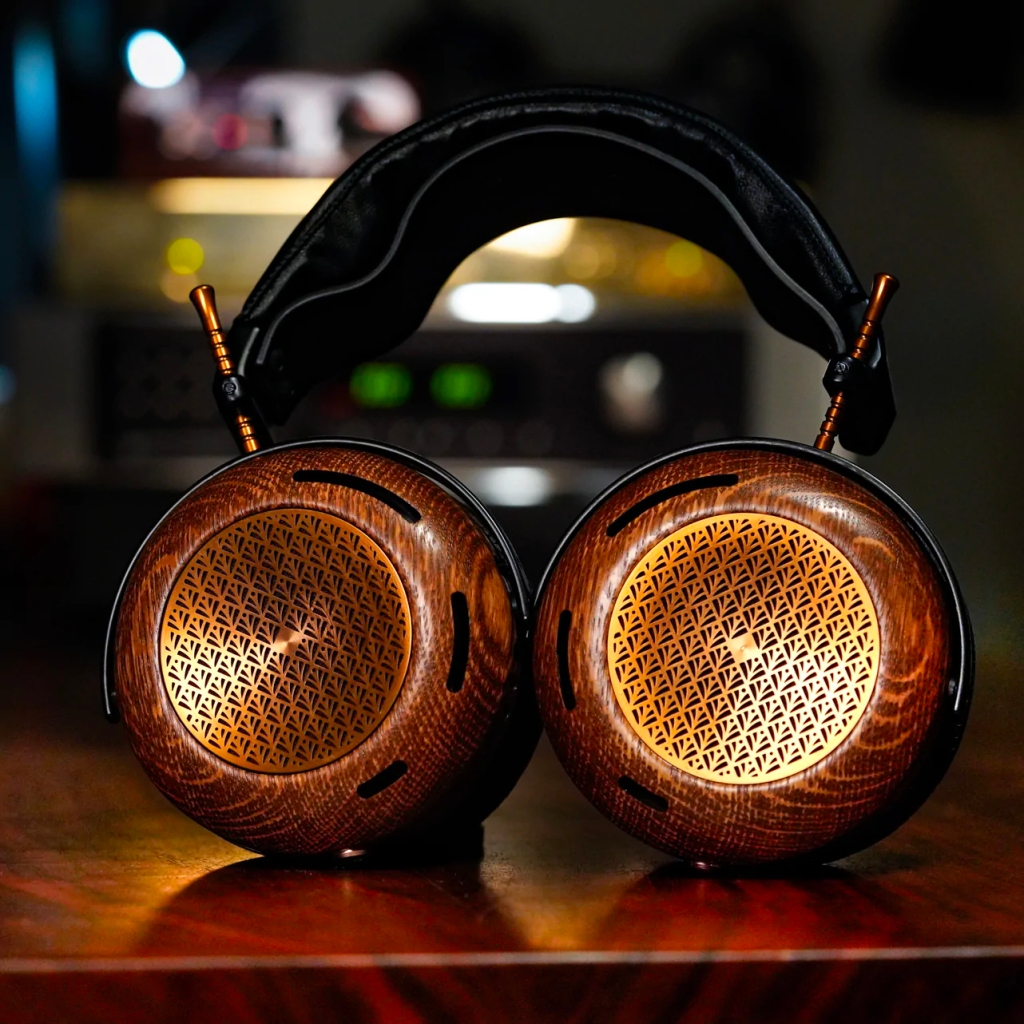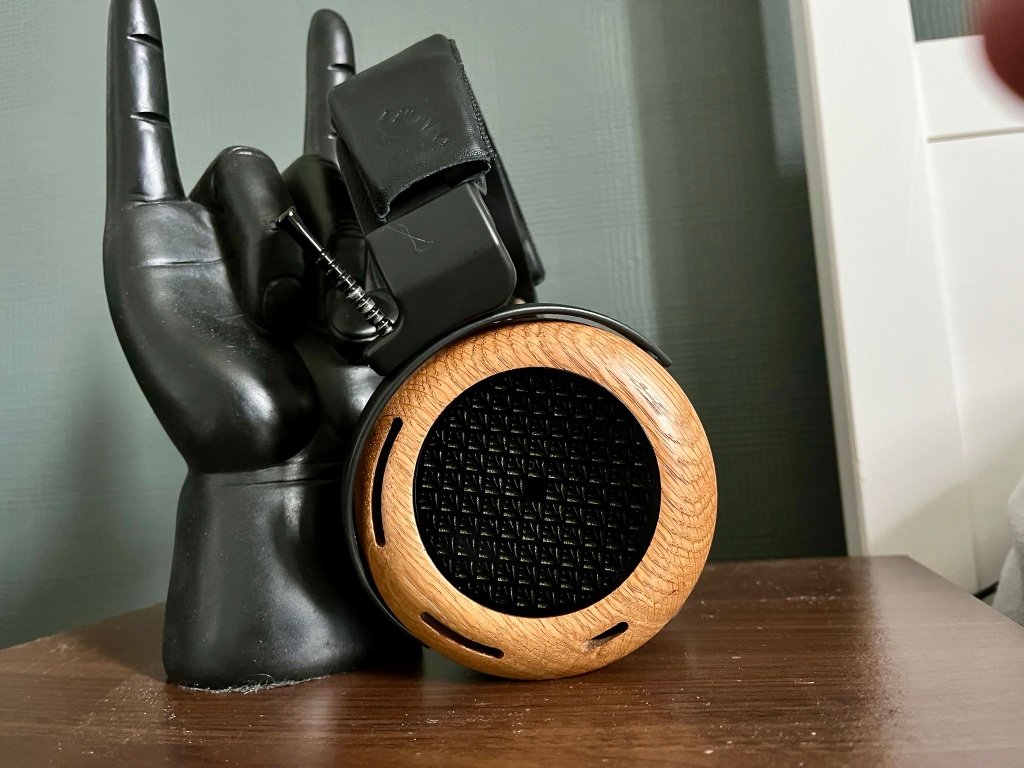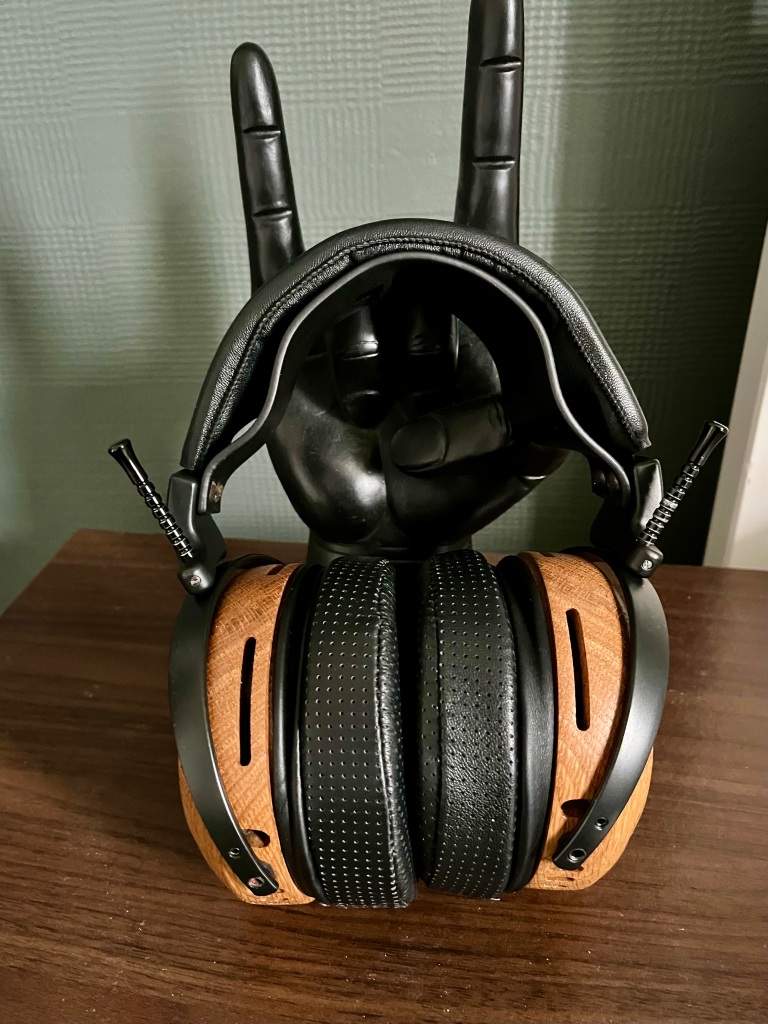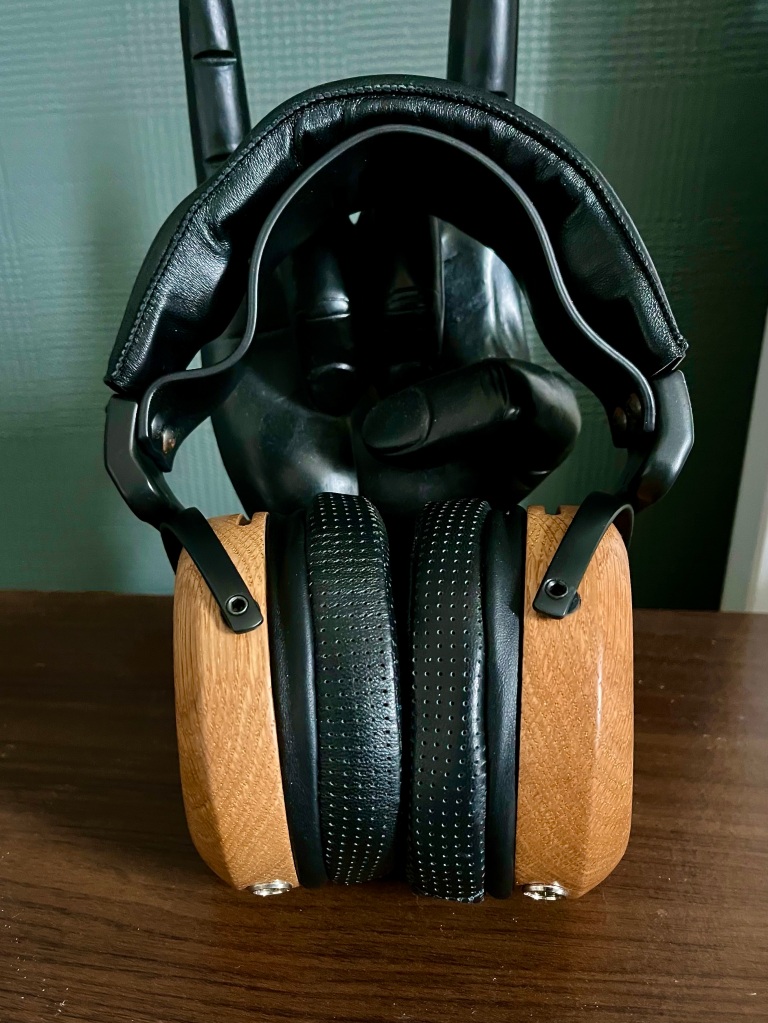Disclaimer:
I approached Zach Mehrbach, the founder and designer of ZMF to ask if it was possible for me to review the Caldera as these headphones really piqued my interest. I have been in the hobby for several years and heard almost all flagship headphones. The last 19 months I enjoyed my Meze Elite, which I prefer to several other, even more expensive headphones. After some emailing, Zach kindly lent me a Caldera for a few weeks. He said, in many ways he likes enthusiast reviews more as these are often more honest and more helpful. I hope this review will qualify as that.
Allow me to skip ZMF history, and topics that were covered hundred times in other reviews and are easy to google. I will only focus on my experience with the Caldera, in a slightly more subjective, but occasionally objective way.
Background:
I love my Meze Elites for their easy-going nature, big soundstage, exceptional comfort and sweet, natural tonality. I enjoy the Elite more than I enjoyed the otherwise excellent Final D8000, fantastic T+A Solitaire P, the famously perfect HiFiMan Susvara or the fast and neutral Audeze LCD-5. Some of these headphones edge out the Meze Elite in certain technical aspects like speed, bass definition or resolution, yet as a whole package I enjoy music through the Elite more. To me, on the right audio chain the Elites are resolving, fast and technical enough, especially with the new angled earpads, while they offer a rare level of musical engagement. This is what the Caldera came to face and challenge.
My audio chain and other amplifiers with the Caldera:
After owning several good delta/sigma DACs like the Chord TT2, RME ADI-2, and great solid-state amplifiers like the HeadAmp GSX Mini, BrystonBHA-1 or iFi iCan Signature, I turned to R2R DACs and tube amplifiers. I find that both the ladder DACs and vintage tubes offer a more natural and lifelike sound making it difficult for me to go back and enjoy the more digital flavour of delta/sigma design or solid-state amplification. The caveat is, that you need to reach a certain level of R2R DACs and tube amps in order to avoid a significant loss of resolution, detail retrieval and speed that entry level models suffer from.
My current audio chain: the EverSolo DMP-A6 is the cleanest sounding streamer I heard. I run Qobuz which I find superior sounding to Tidal. The EverSolo feeds my Musician Pegasus R2R DAC which has been upgraded with a SR Purple Fuse. The upgrade to me enhances clarity. Balanced silver cables lead to my Cayin HA-3A transformer coupled tube amp with NOS tubes. I found the HA-3A a bit lean with stock tubes, so with my current vintage tube set I added warmth, a more natural tone and most of all better bass extension, bass definition, control and body.
(Mullard M8136 CV4003 12AU7 (old logo); Brimar 6V6GT Black Glass D getter; GE 22DE4.) My headphone cable is the Effect Audio CODE23 flagship copper cable which to me is the most detailed and clean sounding copper cable I have heard with excellent, clean and impactful low frequencies.
Some Caldera owners say that these headphones sound the 'best' on good solid-state amplifiers. Others say the sound is fabulous straight out of a simple DAP or portable amp. I had a chance to plug the Caldera into many great and pricey amplifiers at London CanJam, and found that they indeed change with different amps, but I would not always call the change an improvement as you spend more. Synergie is more important than the price tag.
I also think, it is untrue that the Caldera needs solid state amplifiers to shine. These headphones are equally phenomenal or even better out of some transformer coupled tube amps. OTL amps however are better to be avoided due to their high output impedance.
All that said, my favourite combo with the first planar ZMF was the Holo May KTE R2RDAC and Holo Bliss amplifier. They do a fabulous job in achieving a natural sound without tubes. I actually preferred this stack to the three times more expensive dCS Lina. On the Holo combo there was great spaciousness, fantastic weight, speed and impact with a pitch-black background. The Caldera on this stack offers one of the best bass experiences you can have with any headphones on any amps including the Abyss 1266TC.
While my favourite pairing was the top Holo stack, I personally prefer my fine-tuned little tube system versus other popular and pricier d/s and solid-state combinations like the Ferrum OOR/Wandla or the HPA4/DAC3 stack for example. I am not missing out on bass in my system and the sound is just more natural.
ZMF Caldera vs. Meze Elite:
This review will be a close comparison to my Meze Elite, so let us start with the main similarities and differences. They are similarly tuned headphones in a way that they both aim for ultimate musical enjoyment instead of chasing the last five percent of details or pre-set frequency targets. Both headphones are on the warmer side of neutral, at least when it comes to flagship level headphones. They are both musical and engaging with good bass.
That said, to me they are a lot more different than similar, unalike to a much higher degree than expected. The biggest difference is in their nature; the way they represent and portray music. The Elites are the ultimate long-term listening, kick back & relax kind of headphones, the Caldera is a lot bolder and more dynamic, offering a more colourful and more intense listening experience. As we progress with the review, I will shed more light on these differences.
Build and comfort:
Build quality and comfort are exceptional on both of these headphones. ZMF has a more rustic style while the Elite is a modern beauty. Different schools, equally impressive results. The Elite (Empyrean) set a new standard in headphone comfort which is hard to beat and they are often labelled as the most comfortable headphones on Earth. The Caldera is comfortable too, but the Meze wins here. The biggest aspect of this better comfort is sheer weight. The Elite officially weighs 430g, my set is 435g on the kitchen scale. ZMF declares the stock Caldera weight between 490-550g depending on wood variety and headband material. My aged-oak Caldera is 525g. This 90g (~20%) weight increase is noticeable, so unlike the Elite, the Caldera will not disappear like a cloud around your head. They are comfortable enough, and this 500-550g is still within comfort limit for most people who like to listen to music for hours in one go. To me the Caldera is comfortable, but I would not want it to be any heavier.
Sound:
Technicalities, general tonality:
I think, it is safe to say that on technicalities these two headphones are quite even, yet there are some significant differences. When it comes to resolution and fine detail retrieval, they are on a very similar level, but I think the Elite has the edge there, at least with the new angled earpads. The Elites with their laid-back character sound softer, airier and lighter; more ethereal and delicate. The Caldera is lively, energetic and a lot more forward.
The Meze flagship has more air and as a result, the upper frequencies breathe better. Elite's soundstage is noticeably deeper and a lot taller. Width is great on both headphones; the Caldera might even sound a little wider. On all the ZMF earpads, except the thick leather pads, I found the presentation a little too forward, making me feel I am too close to the stage. To me this sensation becomes the strongest on the thin Caldera pads. I will go into the differences on earpads soon, for now let me just say that for my taste I find soundstage depth ideal on the thick ear-pads, but the Elite's perceived stage is still a little deeper.

Within the illusionary space, created by our brains, the notes are exceptionally well-placed on both headphones providing a nice 3Dexperience. Imaging is great in both cases, although they do it in a slightly different manner. Elite's 3D space somehow feels a little more coherent, while the Caldera separates, pulls sounds apart a bit more. It is not that there is not great separation on the Elite, but the Caldera's separation somehow feels more obvious and clearer. This can be good or not that good, depending on the music genre and recording. (Examples for this in the
'example tracks' section.) On psychedelic ambient, trance and EDM tracks this separation is a win for the Caldera, on small acoustic music groups sometimes this can sound a tiny bit overdone.
Tonality is similar on both headphones, slightly warmish neutral. The Caldera is more coloured and intense, the Elite in comparison can sound more neutral and almost slightly drier in a way. The Caldera's most neutral tuning is with the stock pads, all other pads add some extra colour. This colouration is tastefully done, never intrusive and very enjoyable. Just mind, these are not neutral studio headphones (nor are the Elites).
Another big difference between these two contenders is the body, weight and impact of sound. The Elite is smooth, airy, polite, delicate, easy. Caldera is punchy, energetic, the notes have more weight and they hit your eardrums with more impact. This I find very entertaining, satisfying and enjoyable. I think, this is one of the main characteristics that helped to find a fitting name to the headphones: a caldera on a volcano is colourful, alive, energetic, powerful, warm.
Photo of a caldera. Source: Dreamstime
With the right earpad choice this vibrant nature can be tamed a little bit (thick pads for me or suede pads for others), making the Caldera suitable for long-term listening even for those with more sensitive ears. With the stock pads or the thin pads, I always needed a rest after a couple of hours, but with the thick pads I am fine all day. This liveliness is a big positive for a lot of listeners, but the Elite's softer and more gentle presentation will be valued by many as well. With the Elite you can just relax, and for late night listening it might be the better, more ear-friendly choice. The Caldera grabs your attention and entertains.

Speed is a win for the Caldera, pace, rhythm and timing is just sharper (in a good way) and more precise on the ZMF. When these precise notes have weight and impact, that can lead to a whole lot of fun, as the Caldera's tone is warm and organic; unlike some more neutral/brighter speed and detail monster flagships where this sharpness combined with brighter upper frequencies can quickly become bothering. The Caldera is dynamic without trying to stab your eardrums.
This dynamic and lively nature makes the Caldera the most dynamic sounding planar headphones in my experience. I love planar headphones, but many of them can sound a bit weightless, less focused lacking true body and impact. Up to now, for me the Final D8000 was the most dynamic sounding planar with its circular AFDS drivers. The bass on those is excellent and have some dynamic driver characteristics. The Caldera for me exceeds that experience as the whole sound is just a lot closer to dynamic drivers while offers all the positives only planar transducers are capable of reproducing at this level: bass extension, bass presence, clarity and speed.
Earpads:
ZMF at present, offers five different earpad choices for the Caldera. These are advertised as 'fine-tuning' options, but to me they actually change the sound quite significantly. Of course, you are still listening to the same headphones, but many of the characteristics can be altered. It is absolutely worth experimenting, as if you did not like the Caldera with one pair of pads, you might like them with others. There is not one best option, you have to find what suits your taste and ears the best, these are my impressions.
Stock:
these are the safest, best balanced and also the most neutral option. They show off the Caldera's strengths perfectly: punchy, dynamic, speedy and clear. Soundstage feels adequate in size, although it is a lot more forward compared to the Elite. After a couple of hours, depending on the music, I find that the upper-mids/treble can become just a little too intense on them.
Thick:
these bring a bit of extra warmth with ever so slightly elevated mid-bass. Mids and vocals benefit from this, resulting in a slightly richer texture. Treble is politely smoothed out to a very comfortable level. Soundstage feels the biggest: widest, deepest. There might be a slight loss of a few percentages of clarity and punch compared to the stock pads, but those qualities are there in abundance, so it does not feel like a compromise at all.
Suede:
these smoothen and soften the whole sound. Soundstage size is comparable to the stock pads. To my ears with these earpads we lose too much dynamics, speed and punch; the note edges become too rounded and soft. Bass punches lose some energy like putting a blanket on drums.
Thin (cow hide):
to me there is a significant soundstage loss with the thin pads, especially on depth. These are the most forward sounding pads, almost like I was standing on the edge of the stage. Bass punch is great, but somehow the upper frequencies feel more uneven and the whole sound a bit flatter.
Thin (lamb):
these are very similar to the cowhide thin pads, but they do everything in a more polite way, they are not as drastic.
I quite like the stock pads, but eventually settled down with the thick pads. All other pads to my ears take away too much from the Caldera's stock character and/or capabilities.
Mantle mesh:
The mantle mesh is a simple and affordable extra dampening layer that the user can easily apply under the earpads. They meant to dampen treble frequencies for those who find them too pronounced. Zach said, 95% of people are fine without them, but one in twenty might find the mesh useful. Our anatomically different ear-canal shape means we do not hear high frequencies the same way, there can be a 20 dB (!) variation.
I found that the mantle mesh with the stock pads does exactly what it says on the tin. The highs are dampened, toned down, but lower frequencies are unaffected. This might be the ticket for those who want to love the Caldera but just found the upper frequencies slightly too pronounced. For me, the mantle mesh with the stock pads did bring some benefits but took away too much treble detail and liveliness. I still found it an enjoyable sound, just not my choice.
On the other earpads (thick) to my ears the mantle mesh just took away too much from the experience, this combination is not something I would want to listen to.
My ultimate choice after trying all the combinations was the thick pads without the mantle mesh. My number one reason for this is the enhanced soundstage, especially depth. I like a bit of distance between me and the musicians, to remain in the audience and not to climb up on the stage. I also enjoy the slight bass emphasis on the thick pads, while it is hardly taking away anything from the excellent and clean bass impact of the stock pads. Upper mids and treble are a little bit smoothed out, but they still have some sparkle and more details compared to the stock pad/mantle mesh combination.
Bass
Bass is wonderful on both the Elite and the Caldera, but I will not tease you here too long, it is a win for the Caldera. My biggest criticism towards the Elite was always that slightly softer and more politely presented bass which is inherent from the Elite's natural and more laid-back tuning. Do not get me wrong, there is bass quantity and punchy impact on the Meze flagship, just in a more sophisticated and less 'muscular' manner: a little bit like how a Bentley accelerates versus a Lamborghini.
Caldera's bass has more weight and speed. I always enjoyed bass weight and impact more on the LCD4 or Final D8000 compared to the Elite, but those do not have the spacious, airy and natural upper-mid/treble of the Elite. The problem is, you cannot have everything, so eventually I chose the Elite as I very much enjoy this airy, natural and lifelike sound with still a very good bass and exceptional engagement factor. This airy and natural sound usually comes with a soft, diffuse, less focused and/or less impactful bass presentation, like on some oval HiFiMan headphones. The best balance for me between a weighty, impactful bass and natural, airy upper frequencies has been the Elite so far.
Caldera's bass is punchier than the Elite's, it is more physical, more visceral, yet not overblown. Bass is flatter but very speedy and impactful on the stock pads. The thick pads add a little more mid-bass to the picture. In both cases overall bass performance edges out the Elite for me, and even surpasses the fantastic D8000. Being a 'dynamic flavoured' planar, the Caldera does this with natural, open and relatively airy upper frequencies. Not as naturally airy and not as open as the Elite, but enough for me to equally love the overall balance and presentation on both headphones.
Psychedelic ambient or trance is an otherworldly experience on the Caldera: 3D sound with visceral bass impact as if you had the cleanest subwoofers attached to your head.
Mids:
Mids sound organic, they have an excellent warm and lifelike tone; but they are not as shockingly outstanding as the bass performance. Compared to the bass and treble, mids are ever so slightly recessed. This becomes apparent, when on certain tracks the background instruments have as much or even more emphasis as the solo singer in the centre. It is never to a bothering level, but present when comparing the same track on the Elite. (See
'example tracks' section.) On the Elite the focus stays on the singer and the supporting instruments remain more in the background. Everything is audible on the Elite too, just the emphasis and focus feel slightly more accurate for certain genres on the Meze. That said, not always the most accurate presentation is the most entertaining.
Both the Elite and the Caldera have beautiful mids with a good sense of realism and lifelike tonality. To my ears vocal and fine intrument texture, micro-resolution are somehow a bit better on the Elite, but speed and clarity are superior on the Caldera. Caldera sounds more forward and is more intimate due to the slightly less air and smaller stage in comparison. I can enjoy both mid presentations, ultimately to my ears they are equally good, a little bit like roasted or fried potatoes.
Treble:
While treble is smooth and natural on the Caldera with some sparkle, to me the Elite is winning here. The airy and open nature of the Meze flagship helps the upper frequencies to come across even more naturally; perhaps a little brighter but more ear-friendly and less intense. While the treble on the Caldera is still neutral/warm, there is a little more 'bite' to it due to the more energetic nature of the ZMF planar. The treble presentation can be a win either side, depending on the listener's taste. I am relatively treble sensitive, but never really had a problem with the treble on the Caldera, at least not with brightness or sharpness. It is a natural and rounded sounding treble.
On the stock pads, the upper-mid and lower-treble area can become a little overwhelming after a couple of hours, but not because it is sharp or bright, simply due to the sheer energy and intensity this headphone has in general. This for me was completely solved with the thick pads. Others might find the mantle mesh or the suede pads helpful. For the vast majority of people, the stock treble will be absolutely fine.
A few example tracks:
Gaudium– How can I tell: the bass on this track with the Caldera is something to experience, especially what comes after the fourth minute. (If you liked it, try this one too:
Gaudium– Nn.) This is where the Elite or pretty much any other headphones (maybe with the exception of the 1266TC and D8000) cannot really hold a candle.
Offspring– Smash: I used this track for treble testing as it gets very intense. This is what I find too much with the stock pads, but fine on the thick pads (or with the mesh under the stock pads).
Aurora– Conqueror: another example for treble intensity.
Hans Zimmer – Mountains: an example track for grand spaciousness. This I find more enjoyable on the Elite, Caldera's space feels a little more limited in direct comparison.
Sowulo– Wyrd Webba: while both headphones are very good here, the Elite to me somehow gives back a slightly more resolving, a little more natural texture to instruments and voices, perhaps partly due to the bigger space/reverbs. The Caldera's intensity and energy is closer to the track's true nature though.
Telepopmusik– Genetic World: percussion is airier and more natural on the Elite, but bass is more focused on the Caldera.
GiulianoCarmignola II.Allemande Bach Violincello Suit: with this track I find that staging and instrument timbre is a little better on the Elite. It is true nitpicking between two great choices, but the slightly richer reverbs make the sound of the violincello a bit more believable to me on the Meze, while it is still very good on the Caldera. Imaging also becomes a little bit strange on this particular recording. While I see a coherent image on the Elite, Caldera pulls things apart a bit, namely the violincello itself and the breathing of the musician. On the Elite the musician breathes in the centre of the stage as he should, but on the Caldera the breathing somehow comes more from the two sides, while the violincello is in the centre: just a little odd.
Norah Jones Come away with me album (192kHz/24bit): both headphones are beautiful, but what I found is that the vocal on the Elite is more in the spotlight while the instruments are supporting the singer. On the Caldera somehow the instruments become equal participants to the singer.
Conclusion:
What is my conclusion then? In a nutshell, these are my two favourite headphones on today's market. The negatives I mentioned about either of these headphones were nitpicking between two champions in direct comparison.
Zach Mehrbach and Antonio Meze are both brave enough to diverge from mainstream trends, remain unique and follow their own paths. These two headphones have a bit of a character, but for me that is what makes them loveable, enjoyable and engaging. To my ears they both do everything well, and they do different things exceptionally well. Bass, energy, liveliness, organic sound, speed, impact are the Caldera's strengths. Easy listening, coherence, fine texture, natural and airy sound are the strengths of the Elite. I could live with either of them as my only headphones and would pick them over pretty much any other flagships in August 2023.
If it was possible, I would try to combine the Caldera's sublime bass performance with the Elite's natural openness and also find a middle ground between the ZMF energy and the Meze delicacy. For now, I am enjoying both and delaying the tough decision: which one to own long term.
In the Caldera, Zach has managed to combine the magic of his popular dynamic driver headphones with the advantages of planar technology, namely a deeper bass extension, higher overall clarity and superior speed. The Caldera is a true masterpiece with character and personality that many will find endlessly enjoyable. Thank you, Zach, and I hope you will gift us many more wonders in the forthcoming decades!

























